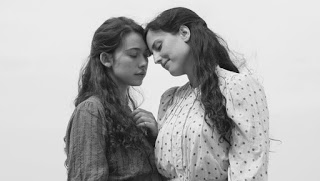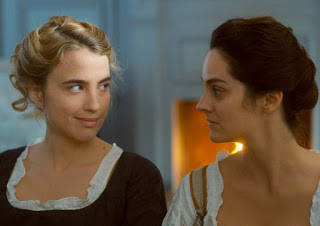 Elisa and Marcela, Marianne and Héloïse, Jean and Lydia
Elisa and Marcela, Marianne and Héloïse, Jean and Lydia
By Julio Martínez Molina
February 8, 2020
Translated and edited by Walter Lippmann for CubaNews
https://walterlippmann.com/elisa-and-marcela-and-more/

Three very recent films on the international scene, two of them exceptional and one of less artistic importance, are interconnected by both the sensitivity and the tenderness with which they have focused the love between two women. Their stories among the most beautiful provided by this thematic plot in the history of the screen. And to affirm it on a slope that has illuminated masterpieces like Carol and wonders like Disobedience is no small thing.
There are certain gay films with male characters who emulate rabbits in their animalistic urge to fornicate at all times, in any space, with anyone, through the vicissitudes of many bodily fluids and little love. On the other hand, these three stories of lesbian romance stand out in contrast, by celebrating the union of a couple with the understanding of an absolute physical and mental communion, one that dispenses with third parties. Then there’s the finding in the person loved the supreme enjoyment in the physical and spiritual, the acceptance of the other with all its burden of differences, their respect as a human being. This does not imply the overflow of eroticism and passion inherent in every bond that also possesses flesh and desire, manifested in the plots of these three filmic pieces bordered by intense sexual passages.
The first two are the Spanish Elisa and Marcela (Isabel Coixet, 2019) and the French Portrait of a Woman on Fire (Céline Sciamma, 2019); the other is the English The Secret of the Bees (Annabel Jankel, 2018). All of them have been directed by women and perhaps that is where the depth of the formation of the six central characters and their human richness lies; fundamentally the complicity in the approach to their sentimental and moral universes.
Co-written and directed by the Catalan Coixet, Elisa and Marcela, is based on true events that took place in primitive Spain, the first homosexual marriage in the history of that country. It occurred in 1901 by two Galician girls, albeit under the premise of a lie: one of them disguised herself as a man. Although it is still valid today, as they could never undo it, in the absence or flight of their spouses.
Teachers Elisa (Natalia de Molina, in another of the notable compositions of a career in ascent) and Marcela (Greta Fernández, the revelation actress of the moment in the Spanish Peninsula) fight at arm’s length to maintain their relationship in a patriarchal scene of ecclesiastical omnipotence. It is still far from being prepared in the psychological and cultural orders to metabolize such a bond. Misunderstood, rejected and ridiculed, the two young women must leave three countries on two continents in order to continue to be together.
The kernel of the story has to be peeled off in the lyricism by which Coixet approaches a love story. It’s shaped, seen and told from the presupposition of that incomparable beauty arising from loving and honoring being the object of veneration and desire. The intimate scenes of the two central characters are carefully beautiful, and they testify to their mime, to the carnality and spirituality of their passion, to the joint desire to please and love each other; in spite of the hatred and ignorance that hangs over both of them. De Molina and Fernandez, especially the first one, were great.
The visual splendor of black and white photography, great in several shots of interiors, enhances the film.
 Portrait of a Woman on Fire, is sensory as the three previous works of its director, garments the model gradualness through which Sciamma works the romantic attraction of its protagonists. In the first hour of the film, which is calm in its progression and full of details, references and subtleties (those furtive or frontal glances of Héloïse, the lady to be painted, towards Marianne, the painter!
Portrait of a Woman on Fire, is sensory as the three previous works of its director, garments the model gradualness through which Sciamma works the romantic attraction of its protagonists. In the first hour of the film, which is calm in its progression and full of details, references and subtleties (those furtive or frontal glances of Héloïse, the lady to be painted, towards Marianne, the painter!
The two are also in conflict with each other. It was 1770 and the beautiful young bourgeois Héloïse had to be painted, in order to send the canvas to the rich Milanese man who was to marry her. Marianne represents, there is no other, given the time and the conventions, an episode that – although probably the most important thing in her life and never forgotten by her – has to be closed within itself once the lady travels to Italy with her husband.
Noémi Merlant (Marianne) and Adèle Haenel (Héloïse) compose two memorable characterizations. This is decisive in the sense of capturing their characters’ attempt to curb an instantaneous drive and the vehemence with which they accept it and give themselves over to the love affair after realizing how futile the commitment is. The stylization of Portrait of a Woman on Fire is largely due to the observation of the bodies and the close-ups. It’s pure filmic visual poetry that dialogues and transmutes with the pictorial space of the story. Thanks to the mailbox of Claire Mathom, the director of photography.
 Despite being weighed down by dramatic and visually mellifluous decisions in the resolution, as well as appeals to misplaced magical realism and less nuance, The Secret of the Bees is also another tender female story. It is the 1950s in a rural Scotland that does not forgive the “lesbian” Dr. Jean (Anna Paquin, in a work of introversion unaccustomed to the actress in recent times), much less its clandestine union with the young worker Lydia (Holliday Grainger). The relationship between the two, despite their desire for anonymity, will be revealed in the air of a closed atmosphere of intolerance.
Despite being weighed down by dramatic and visually mellifluous decisions in the resolution, as well as appeals to misplaced magical realism and less nuance, The Secret of the Bees is also another tender female story. It is the 1950s in a rural Scotland that does not forgive the “lesbian” Dr. Jean (Anna Paquin, in a work of introversion unaccustomed to the actress in recent times), much less its clandestine union with the young worker Lydia (Holliday Grainger). The relationship between the two, despite their desire for anonymity, will be revealed in the air of a closed atmosphere of intolerance.
In director Jankel’s eyes, this love is marked by tenderness. Although the observation of the two women’s intimate space never reaches the degree of visual sophistication of the films of La Coixet and La Sciamma, such scenes are also very beautiful. Perhaps they are less stylized, but not all of them need to be assumed in such a way.

You must be logged in to post a comment.